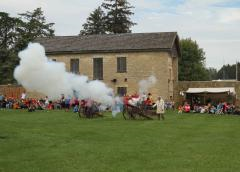
Fort Atkinson will celebrate the 40th anniversary of Rendezvous Days on Sept. 23-25. Photo by Paul R. Herold
By Ashley Rullestad
Fort Atkinson was never the site of any bloody battles or major victories, nor did it create any war heroes. Nevertheless, it holds historical significance for the people of Winneshiek County as a flashback to life on the new frontier in the 1840s.
Throughout the 1830s, the Winnebago or Ho-Chunk American Indians resisted leaving their homelands in what is now Wisconsin. The Winnebago signed their first treaty with the United States in 1816 and signed boundary and cession treaties in the 1820s and 1830s. Due to the treaties, the Winnebago were moved from their homeland in Wisconsin and resettled in the Iowa Territory. However, many Winnebago had concern for moving into the region near their old enemies, the Sioux. The old region contained their tribal burial grounds and many regularly attempted to escape back to Wisconsin.
Gen. Henry Atkinson suggested establishing a temporary fort along the Turkey River within the neutral ground, a 40-mile wide strip of land that was established by the Treaty of 1830, where the Winnebago were to reside. Thus, the purpose of the fort was to keep the Winnebago tribe on Neutral Ground and keep them from escaping to Wisconsin. The soldiers at the fort were also to keep the peace on the frontier between the Winnebago, Sioux, Sauk and Meskwaki tribes and Euro-American settlers.
On May 31, 1840, a camp was made on the site of the future fort. The camp was named Atkinson in honor of the commanding officer in charge of the Winnebago resettlement efforts.
TO READ MORE ABOUT THIS STORY AND OTHER FASCINATING STORIES ABOUT IOWA HISTORY, subscribe to Iowa History Journal. You can also purchase back issues at the store.
